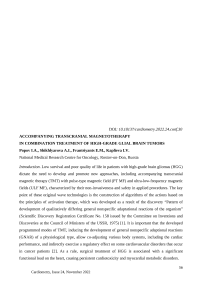Accompanying transcranial magnetotherapy in combination treatment of high-grade glial brain tumors
Автор: Popov I.A., Shikhlyarova A.I., Frantsiyants E.M., Kaplieva I.V.
Журнал: Cardiometry @cardiometry
Статья в выпуске: 24, 2022 года.
Бесплатный доступ
Introduction. Low survival and poor quality of life in patients with high-grade brain gliomas (HGG) dictate the need to develop and promote new approaches, including accompanying transcranial magnetic therapy (TMT) with pulse-type magnetic field (PT MF) and ultra-low-frequency magnetic fields (ULF MF), characterized by their non-invasiveness and safety in applied procedures. The key point of these original wave technologies is the construction of algorithms of the actions based on the principles of activation therapy, which was developed as a result of the discovery “Pattern of development of qualitatively differing general nonspecific adaptational reactions of the organism” (Scientific Discovery Registration Certificate No. 158 issued by the Committee on Inventions and Discoveries at the Council of Ministers of the USSR, 1975).
Короткий адрес: https://sciup.org/148326323
IDR: 148326323 | DOI: 10.18137/cardiometry.2022.24.conf.30
Текст статьи Accompanying transcranial magnetotherapy in combination treatment of high-grade glial brain tumors
National Medical Research Centre for Oncology, Rostov-on-Don, Russia
Introduction . Low survival and poor quality of life in patients with high-grade brain gliomas (HGG) dictate the need to develop and promote new approaches, including accompanying transcranial magnetic therapy (TMT) with pulse-type magnetic field (PT MF) and ultra-low-frequency magnetic fields (ULF MF), characterized by their non-invasiveness and safety in applied procedures. The key point of these original wave technologies is the construction of algorithms of the actions based on the principles of activation therapy, which was developed as a result of the discovery “Pattern of development of qualitatively differing general nonspecific adaptational reactions of the organism” (Scientific Discovery Registration Certificate No. 158 issued by the Committee on Inventions and Discoveries at the Council of Ministers of the USSR, 1975) [1]. It is important that the developed programmed modes of TMT, inducing the development of general nonspecific adaptional reactions (GNAR) of a physiological type, allow co-adjusting various body systems, including the cardiac performance, and indirectly exercise a regulatory effect on some cardiovascular disorders that occur in cancer patients [2]. As a rule, surgical treatment of HGG is associated with a significant functional load on the heart, causing persistent cardiotoxicity and myocardial metabolic disorders.
Cardiometry, Issue 24, November 2022
The aim of our research study was to form an integral adaptational reaction of the antistressor type and correct some metabolic myocardial disorders based on a comprehensive cardiometric analysis of the cardiac performance in patients with brain HGG by applying TMT at the stage of surgical treatment.
Results . On postsurgery day 7 in the patients of the main group, the average oxygen index in the myocardium was 0.7 s.u. against the reference value of 0.5 s.u. (p=0.04); on postsurgery day 15 it was recorded to be 0.6 s.u. against 0.4 s.u. (p=0.04), respectively. The level of lactate on postsurgery day 7 in the main group was 4.3 s.u. against 17.1 s.u. (p=0.03) in the reference group; on postsurgery day 15 the lactate level was recorded to be 4.4 s.u. against the reference group value of 15.1 s.u., respectively (p=0.03). The level of phosphocreatine in the patients of the main group on postsurgery day 15 was 4.2 s.u., while in the reference group it was recorded to be 4.8 s.u. (p=0.05). In both groups, the existing wide range of the initial normotypes of reactions (training, calm and elevated activation) in the period before surgery and immediately after the surgical treatment narrowed sharply to the identical type of pathological response, i.e. the development of acute stress in 70–80% of the cases. During the period of TMT exposure, starting from the second 57 Cardiometry, Issue 24, November 2022
day after the operation and before the start of radiation therapy, there was a decrease in the rate of stress reactions by 3.4 times and the dominance of stable normotypes of anti-stress reactions, beginning with the reaction of training to elevated activation that was confirmed by an increase in C=AS/S by 3.0 times against the respective reference values. Thus, in the reference group without the TMT application, in the development of a stress state, inhibition of the aerobic energy processes in the myocardium was observed with activation of the anaerobic-glycolytic and anaerobic-alactate processes, and oxygen deficiency was compensated by an increase in the lactate and phosphocreatine levels. In the patients of the main group, after TMT, the indices of oxygen, lactate and phosphocreatine remained within the physiological norm, and the stable normotypes of the antistress reactions developed.
Conclusion . The use of accompanying TMT at the stage of surgical treatment of HGG determines the dominance of the anti-stress adaptational reactions that contributes to the prevention of the development of stress and myocardial dysfunction and to an earlier restoration of the quality of life in such patients.
Список литературы Accompanying transcranial magnetotherapy in combination treatment of high-grade glial brain tumors
- Garkavi L.Kh., Ukolova M.A., Kvakina E.B. "The pattern of development of qualitatively different general nonspecific adaptive reactions of the organism.
- Garkavi L.Kh., Kvakina E.B., Kuzmenko T.S., Shikhlyarova A.I. Antistress reactions and activation therapy. Activation reaction as a path to health through self-organization processes. Yekaterinburg: "Philanthropist", 2002.


